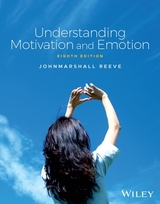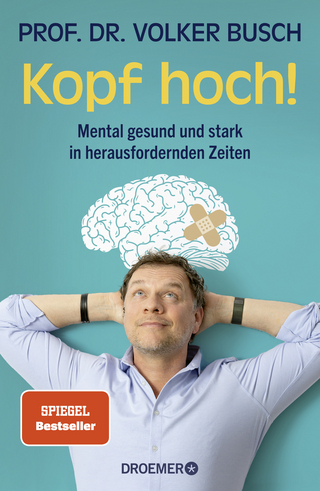
Understanding Motivation and Emotion
John Wiley & Sons Inc (Verlag)
978-1-119-36760-4 (ISBN)
In the midst of the field's "golden age," there has never been a better time to merge new understanding and practical application to improve people’s lives. Useful in schools, the workplace, clinical settings, health care, sports, industry, business, and even interpersonal relationships, these concepts are profoundly powerful; incorporated into the state-of-the-art intervention programs detailed here, they can enhance people's motivation, emotion, and outlook while answering the core questions of any human interaction.
Preface iii
CHAPTER 1 INTRODUCTION 1
What Is Motivation? Why Is It Important? 2
Motivational Science 4
Two Perennial Questions 5
What Causes Behavior? 5
Why Does Behavior Vary in Its Intensity? 7
Subject Matter 7
Internal Motives 8
External Events and Social Contexts 9
Motivation versus Influence 10
Expressions of Motivation 10
Behavior 10
Engagement 11
Psychophysiology 12
Brain Activations 12
Self-Report 13
Framework to Understand Motivation and Emotion 13
Ten Unifying Themes 14
Motivation and Emotion Benefit Adaptation and Functioning 14
Motivation and Emotion Direct Attention 15
Motivation and Emotion Are “Intervening Variables” 16
Motives Vary Over Time and Contribute into the Ongoing Stream of Behavior 16
Types of Motivations Exist 17
We Are Not Always Consciously Aware of the Motivational Basis of Our Behavior 18
Motivation Study Reveals What People Want 19
To Flourish, Motivation Needs Supportive Conditions 19
When Trying to Motivate Others, What Is Easy to Do Is Rarely What Works 20
There Is Nothing So Practical as a Good Theory 21
Summary 21
CHAPTER 2 MOTIVATION AND EMOTION IN HISTORICAL PERSPECTIVE 24
Philosophical Origins of Motivational Concepts 25
Grand Theories 26
Will 26
Instinct 26
Drive 28
Rise of the Mini-Theories 33
Active Nature of the Person 34
Cognitive Revolution 35
Socially Relevant Questions 35
Contemporary Era 37
The 1990s Reemergence of Motivation Study 38
Brief History of Emotion Study 40
Conclusion 41
Summary 42
Readings for Further Study 43
CHAPTER 3 THE MOTIVATED AND EMOTIONAL BRAIN 44
Motivation, Emotion, and Neuroscience 46
Day-to-Day Events Activate Specific Brain Structures 46
Activated Brain Structures Generate Specific Motivations and Emotions 47
Neural Basis of Motivation and Emotion 47
Cortical Brain 47
Subcortical Brain 48
Bidirectional Communication 48
Individual Brain Structures Involved in Motivation and Emotion 49
Subcortical Brain Structures 50
Cortical Brain Structures 59
Hormones 65
Summary 67
Readings for Further Study 68
PART I NEEDS 69
CHAPTER 4 PHYSIOLOGICAL NEEDS 71
Need 72
Three Types of Needs 72
Fundamentals of Regulation 74
Physiological Need 75
Psychological Drive 75
Homeostasis 75
Negative Feedback 76
Multiple Inputs/Multiple Outputs 76
Intraorganismic Mechanisms 77
Extraorganismic Mechanisms 77
Homeostatic Mechanism 77
Thirst 78
Physiological Regulation 79
Environmental Influences 80
Hunger 81
Short-Term Appetite 81
Long-Term Energy Balance 82
Environmental Influences 84
Self-Regulatory Influences 85
Weight Gain and Obesity 86
Comprehensive Model of Hunger 87
Sex 88
Physiological Regulation 88
Facial Metrics 90
Sexual Scripts 93
Sexual Orientation 94
Evolutionary Basis of Sexual Motivation 94
Summary 96
Readings for Further Study 97
CHAPTER 5 EXTRINSIC MOTIVATION AND INTERNALIZATION 98
Extrinsic Motivation 100
Incentives and Consequences 100
Incentives 101
Reinforcers 101
Managing Behavior 102
Consequences 103
Hidden Costs of Reward 106
Intrinsic Motivation 107
Intrinsic Motivation versus Extrinsic Motivation 108
Expected and Tangible Rewards 111
Implications 111
Benefits of Extrinsic Motivation 111
Cognitive Evaluation Theory 112
Two Examples of Controlling and Informational Events 113
Types of Extrinsic Motivation 115
External Regulation 117
Introjected Regulation 117
Identified Regulation 117
Integrated Regulation 118
Internalization and Integration 118
Motivating Others on Uninteresting Activities 119
Amotivation 120
Summary 121
Readings for Further Study 122
CHAPTER 6 PSYCHOLOGICAL NEEDS 123
Psychological Needs 124
Organismic Psychological Needs 125
Benefits of Need Satisfaction 125
Need Frustration 127
Autonomy 128
Supporting Autonomy 129
The Conundrum of Choice 134
Benefits from Autonomy Support 135
Giving and Receiving Autonomy Support 136
Competence 136
Optimal Challenge 137
Flow 137
Structure 139
Failure Tolerance 141
Relatedness 142
Involving Relatedness 143
Satisfying Relatedness 143
Supporting Relatedness 144
Communal and Exchange Relationships 145
Benefits from Relatedness Need Satisfaction 146
Putting it All Together: Relationships and Social Contexts that Support Psychological Need
Satisfaction 146
Engagement 147
What Makes for a Good Day? 147
Vitality 149
Summary 149
Readings for Further Study 150
CHAPTER 7 IMPLICIT MOTIVES 152
Implicit Motives 154
Acquired Needs 155
Social Needs 155
How Implicit Motives, as Acquired Psychological Needs, Motivate Behavior 158
Achievement 159
Origins of the Need for Achievement 160
Atkinson’s Model 161
Achievement for the Future 163
Dynamics-of-Action Model 163
Conditions That Involve and Satisfy the Need for Achievement 165
Affiliation 166
Duality of Affiliation Motivation 167
Conditions That Involve the Affiliation and Intimacy Duality 167
Conditions That Satisfy the Affiliation Need 168
Power 169
Conditions That Involve and Satisfy the Need for Power 170
Goal Pursuit and Perspective Taking 172
Is the Implicit Power Motive Bad? 172
Leadership Motive Pattern 172
Compassionate Leadership Profile 173
Four Additional Social Needs 175
Summary 175
Readings for Further Study 176
PART II COGNITIONS 177
CHAPTER 8 GOAL SETTING AND GOAL STRIVING 179
Cognitive Springs to Action 180
Plans 181
Corrective Motivation 183
Discrepancy 183
Discrepancy, Emotions, and Feelings 184
Two Types of Discrepancy 185
Goal Setting 186
Goal–Performance Discrepancy 186
Difficult, Specific, and Congruent Goals Enhance Performance 187
Feedback 189
Criticisms 190
Long-Term Goal Setting 192
From Where Do Goals Come? 192
Goal Striving 193
Mental Simulations 193
Implementation Intentions 194
Goal Disengagement 198
Summary 200
Readings for Further Study 201
CHAPTER 9 MINDSETS 202
Mindset 203
Mindset 1: Deliberative–Implemental 203
Deliberative Mindset 205
Implemental Mindset 205
Downstream Consequences of the Deliberative and Implemental Mindsets 206
Mindset 2: Promotion–Prevention 206
Promotion Mindset 207
Prevention Mindset 208
Different Definitions of Success and Failure 208
Different Goal-Striving Strategies 209
Ideal Self-Guides and Ought Self-Guides 210
Regulatory Fit Predicts Strength of Motivation and Well-Being 211
Mindset 3: Growth-Fixed 211
Fixed Mindset 212
Growth Mindset 212
Meaning of Effort 212
Origins of Fixed-Growth Mindsets 214
Different Fixed-Growth Mindsets Lead to Different Achievement Goals 215
Achievement Goals 217
Cognitive Dissonance 221
Dissonance-Arousing Situations 222
Motivational Processes Underlying Cognitive Dissonance 224
Self-Perception Theory 224
Summary 225
Readings for Further Study 226
CHAPTER 10 PERSONAL CONTROL BELIEFS 227
Motivation to Exercise Personal Control 228
Two Kinds of Expectancy 229
Perceived Control: Self, Action, and Control 230
Coping with Failure 230
Self-Efficacy 231
Sources of Self-Efficacy 233
Self-Efficacy Effects on Behavior 235
Empowerment 237
Empowering People: Mastery Modeling Program 238
Mastery Beliefs 239
Ways of Coping 239
Mastery versus Helplessness 239
Learned Helplessness 240
Learning Helplessness 241
Application to Humans 242
Components 243
Helplessness Effects 244
Helplessness and Depression 245
Attributions and Explanatory Style 246
Reactance Theory 249
Expectancy–Value Model 250
Value 251
Value Interventions 252
Summary 252
Readings for Further Study 253
CHAPTER 11 THE SELF AND ITS STRIVINGS 255
Two Views of Self 256
Self-as-Object 257
Self-as-Agent 257
The Problem with Self-Esteem 258
Self-Concept 259
Self-Schemas 260
Motivational Properties of Self-Schemas 260
Consistent Self 261
Self-Verification versus Self-Concept Change 262
Why People Self-Verify 263
Possible Selves 263
Identity 266
Roles 267
Connections to Social Groups 267
Situations Make Specific Identities Salient 267
Agency 268
Self as Action and Development from Within 268
True Self? 269
Self-Concordance 270
Intrinsic Goals and Extrinsic Goals 271
Self-Regulation 273
Forethought through Reflection 273
Developing More Competent Self-Regulation 274
Self-Control 275
Is the Capacity to Exert Self-Control Beneficial to a Successful Life? 279
Summary 279
Readings for Further Study 280
PART III EMOTIONS 283
CHAPTER 12 NATURE OF EMOTION: SIX PERENNIAL QUESTIONS 285
Six Perennial Questions 286
What is an Emotion? 287
Definition 288
Relation between Emotion and Motivation 290
What Causes an Emotion? 291
Two-Systems View 292
Chicken-and-Egg 293
What Ends an Emotion? 294
How Many Emotions are There? 294
Biological Perspective 294
Cognitive Perspective 296
Reconciliation of the Numbers Issue 297
What Good are the Emotions? 299
Coping Functions 299
Social Functions 300
Why We Have Emotions 302
Can We Control Our Emotions? 303
Emotion Regulation Strategies 304
What is the Difference Between Emotion and Mood? 306
Everyday Mood 306
Positive Affect 308
Summary 310
Readings for Further Study 311
CHAPTER 13 ASPECTS OF EMOTION 313
Biological Aspects of Emotion 314
James–Lange Theory 315
Contemporary Perspective 315
Brain Activity Activates Individual Emotions 317
Facial Feedback Hypothesis 318
Cognitive Aspects of Emotion 324
Appraisal 324
Complex Appraisal 327
Appraisal as a Process 329
Emotion Differentiation 330
Emotion Knowledge 331
Attributions 332
Emotions Affect Cognition 334
Social Aspects of Emotion 334
Social Interaction 334
Social Sharing of Emotion 335
Summary 337
Readings for Further Study 338
CHAPTER 14 INDIVIDUAL EMOTIONS 339
Basic Emotions 340
Fear 341
Anger 342
Disgust 343
Contempt 344
Sadness 345
Emotional Preparation for Threat and Harm 346
Joy 346
Interest 347
Emotional Preparation for Motive Involvement and Satisfaction 348
Self-Conscious Emotions 348
Shame 348
Guilt 350
Embarrassment 351
Pride 352
Triumph 352
Interrelations among Shame, Guilt, Embarrassment, Pride, and Hubris 353
Cognitively Complex Emotions 353
Envy 353
Gratitude 355
Disappointment and Regret 356
Hope 357
Schadenfreude 357
Empathy 358
Compassion 359
Summary 360
Readings for Further Study 361
PART IV APPLIED CONCERNS 363
CHAPTER 15 GROWTH MOTIVATION AND POSITIVE PSYCHOLOGY 365
Holism and Positive Psychology 367
Holism 368
Positive Psychology 368
Self-Actualization 368
Hierarchy of Human Needs 369
Encouraging Growth 371
Actualizing Tendency 371
Organismic Valuing Process 372
Emergence of the Self 373
Conditions of Worth 374
Conditional Regard as a Socialization Strategy 376
Fully Functioning Individual 378
Organismic Integration 379
Humanistic Motivational Phenomena 379
Causality Orientations 379
Growth-Seeking versus Validation Seeking 380
Relationships 381
Freedom to Learn 382
Self-Definition and Social Definition 382
Problem of Evil 383
Positive Psychology 385
Happiness and Well-Being 385
Eudaimonic Well-Being 387
Optimism 388
Meaning 389
Positivity 390
Mindfulness 391
Interventions 391
Cultivating Hope 392
Cultivating Compassion 392
Criticisms 394
Summary 395
Readings for Further Study 396
CHAPTER 16 UNCONSCIOUS MOTIVATION 397
Psychodynamic Perspective 398
Psychoanalytic Becomes Psychodynamic 399
Dual-Instinct Theory 400
Do the Id and Ego Actually Exist? 401
Contemporary Psychodynamic Theory 402
The Unconscious 403
Freudian Unconscious 403
Adaptive Unconscious 404
Implicit Motivation 406
Priming 407
Psychodynamics 408
Repression 409
Suppression 409
Terror Management Theory 411
Ego Psychology 412
Ego Development 412
Ego Defense 413
Ego Effectance 415
Object Relations Theory 416
Criticisms 419
Summary 420
Readings for Further Study 421
CHAPTER 17 INTERVENTIONS 423
Applying Principles of Motivation and Emotion 424
Explaining Motivation and Emotion 424
Predicting Motivation and Emotion 425
Solving Motivational and Emotional Problems 425
Practice Problems 426
Three State-of-the-Art Interventions 428
Preface 428
Intervention 1: Satisfying Psychological Needs 428
Intervention 2: Increasing a Growth Mindset 431
Intervention 3: Promoting Emotion Knowledge 434
Wisdom Gained from a Scientific Study of Motivation and Emotion 436
References 439
Author Index 515
Subject Index 530
| Erscheinungsdatum | 30.03.2018 |
|---|---|
| Verlagsort | New York |
| Sprache | englisch |
| Maße | 201 x 252 mm |
| Gewicht | 953 g |
| Themenwelt | Sachbuch/Ratgeber ► Gesundheit / Leben / Psychologie ► Psychologie |
| Geisteswissenschaften ► Psychologie | |
| ISBN-10 | 1-119-36760-3 / 1119367603 |
| ISBN-13 | 978-1-119-36760-4 / 9781119367604 |
| Zustand | Neuware |
| Informationen gemäß Produktsicherheitsverordnung (GPSR) | |
| Haben Sie eine Frage zum Produkt? |
aus dem Bereich



